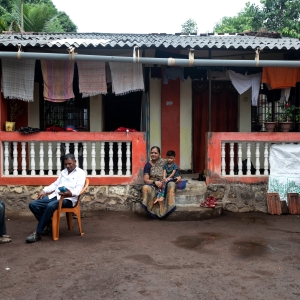|
Getting your Trinity Audio player ready...
|
For the past decade, India has been a leader in developing its digital public infrastructure to enable the next generation of inclusive financial development (see India Stack). Despite significant advances, however, formal credit in rural and low-income households remains a significant challenge. Per the 2021 Global Findex, 45% of adults reported borrowing in India; however, only a third did so from a formal source. From the perspective of financial institutions (FIs), it is still too expensive to reach rural, underserved populations due to their geographical remoteness and the lack of access to customer data. As a result, rural customers are left with few, often informal, borrowing options.
In early 2022, CGAP, Sahamati, and the India Post Payments Bank (IPPB) decided to partner to create a solution that will ensure every household in India has access to formal lending products. We saw the opportunity to enable IPPB’s 56,000-strong rural agent network to viably offer digital loans from various FIs to underserved rural customers who already own smartphones. To do this, we will leverage account aggregators (AAs), part of the India Stack, to enable the system integration required to connect customers, agents, lenders, and holders of customer data. We are still developing the solution, but if it proves to be successful once active, customers will benefit from accessing a wider choice of loans, digital lenders subscribed to the AA ecosystem will grow their market, and IPPB will offer its customers greater service diversity while enhancing the viability of its rural agent network.
Based on customer research and interviews with industry experts, the proposed solution will be a self-service lending mobile app used with the assistance of IPPB’s rural postal agents to ensure consumer trust in the product and a seamless application process. The customer journey will be entirely paperless and take under 10 minutes from application to loan disbursal. As we prepare to launch the pilot, we want to share lessons from the business model and app design process thus far.
Determining a model – what do rural households want?
The project’s first step was to evaluate the target customer segment’s needs and the ability of the hypothesized solution to meet them. To do this, we partnered with MicroSave Consulting (MSC) to develop a survey that focused on assessing financing needs, usage levels of formal finance, and attitudes toward agents and financial institutions.
The results highlighted that the current process of applying for a formal loan is cumbersome – it can take up to 15 days, a considerable amount of paperwork, and multiple interactions with lenders before a loan is approved. Nonetheless, customers trust formal FIs when it comes to borrowing as they provide lower interest rates, timely loan disbursals, and adequate support from bank employees.
Finally, participants strongly preferred lenders who assist in the application process – . These insights provided the foundations that dictated our choice model choice (a self-service app with agent assistance).
The proposed app lowers customer costs mainly from the reduced time needed to get all the paperwork usually required by FIs and allows the customer to shop around for borrowing options. For lenders, it makes the loan documentation collection process faster and cheaper, and with the data from the AAs, they should be able to make more adequate loan offerings. The model is described below.

Lessons from the design process
Lesson 1: High-tech solutions need high-touch assistance adapted to low-tech customers
Many FIs already offer digital loans; however, for our target – rural customers with smartphones – the process remains complex, and they often lack the confidence to complete loan applications by themselves. A simple user experience combined with agent assistance could be the key to successful uptake.
The local app developer firm Jocata teamed up with international designer IDEO to ensure that the UX for the app is a simple, intuitive, and visual solution for an audience with low literacy/low digital literacy rates. This resulted in what will be a lending journey based primarily on icons, with no small text or complicated disclosures, and with easy-to-understand information about each step and the documentation required to complete the application process. CGAP, IPPB, Sahamati, and several lenders were actively involved in the design process to ensure all regulatory requirements, product descriptions, and branding were considered.
To further ensure complete customer understanding and trust in the product and application process, the postal agents will be trained with the assistance of Jocata. Agents will be empowered to answer customer questions throughout the application process and to provide information on recourse channels in case issues arise after the application is processed and the agent has moved on.
Lesson # 2: A significant amount of coordination and commitment from different stakeholders has been pivotal for the success of the project thus far
Designing a good app was only part of the process. An innovative backend architecture where different partners can integrate seamlessly has been one of the project’s biggest challenges. Jocata had to figure out how to connect all FIs to the app through the AAs and the open API OCEN (Open Credit Enablement Network). This entailed significant coordination, commitment, and economic investment from the principal stakeholders, as well as an appetite to venture into new territories.
Potential impacts on consumer protection
In addition to lessons learned from the design process, we’ve also identified important customer protection implications stemming from the proposed model.
Implication 1: A customer-centric formal lending marketplace can increase product transparency and empower customers to make more informed decisions. Lenders who want to participate in the ecosystem must present key product terms and disclosures to customers consistently and comparably.
Implication 2: The combination of a user-friendly app with agent assistance can reduce fraud and data privacy risks while providing customer support throughout the process. A self-service app will ensure that customers are the ones to provide the data and make their own decisions. Still, the agent can answer customer questions during the application to generate trust.
From a fraud perspective, some lenders have reported to Sahamati that the risk of customers providing fraudulent documentation has been eliminated since FIs verify customer data directly via the AA system.
Implication 3: A centralized, lender-agnostic app enabled by IPPB can reduce the risk of agent product steering. If agents are to be paid the same commission independent of the lender or the loan amount, it should eliminate their incentives to steer customers toward specific products or providers.
Will this process be replicable elsewhere?
The journey to provide digital-only, customer-centric loans to rural and low-income households is highly specific to India (i.e., India Stack, Account Aggregators, and OCEN); however, some lessons from this context can also guide efforts in other countries.
Policymakers and regulators should provide a long-term strategy to build integrated financial systems and invest in interoperable infrastructure so the formal financial sector can leverage and innovate on these public rails.
. The case in India is a perfect example of an untapped formal lending market, a cutting-edge financial infrastructure, and an exceptionally far-reaching agent network. However, no single stakeholder can create the solution by themself.
Funders can play a crucial role in two dimensions. First, by connecting stakeholders and facilitating discussions to design feasible and sustainable solutions. Second, by providing thought leadership, research, and resources where no other single participant has the incentive to do so.
What lies ahead?
Offering formal small-value credit to millions of households at this scale is unprecedented, and this pilot is the first time it will be attempted. The project has had its fair share of challenges so far, but we are excited about its potential impact to increase the value of financial accounts for low-income customers in India. Stay tuned for the pilot results!



